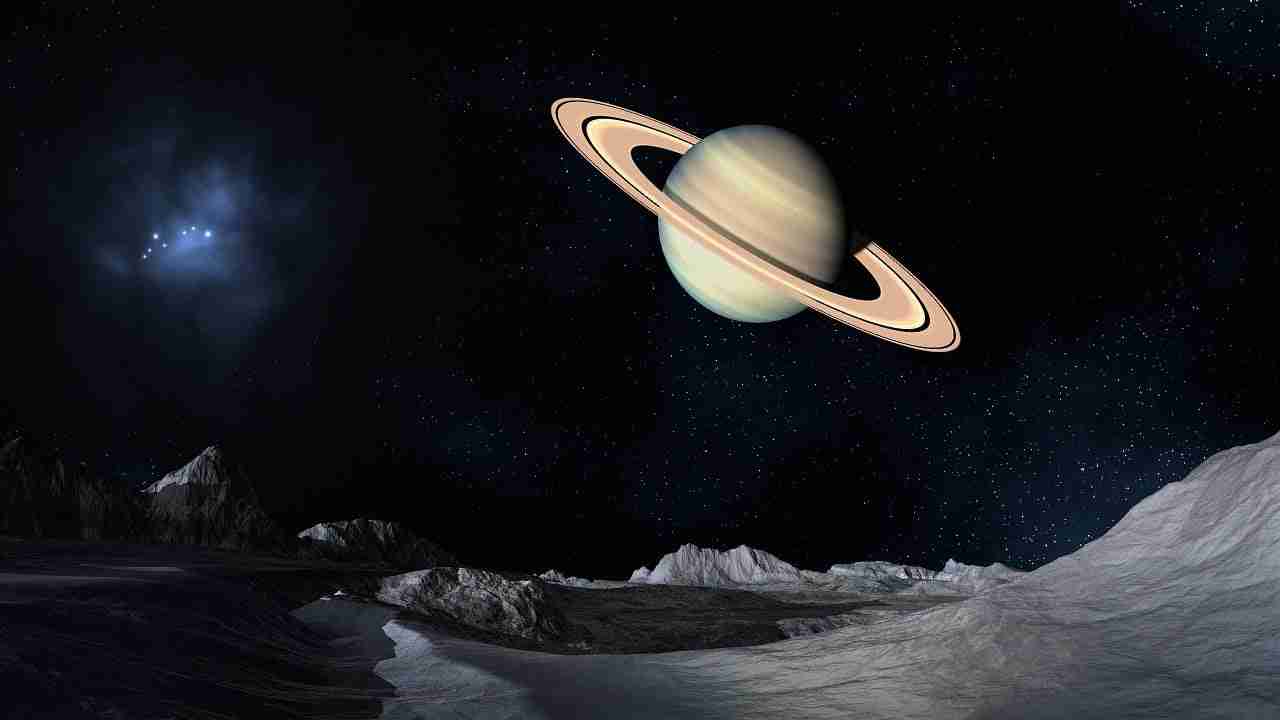22 Fun Facts About Saturn | Rings of Cosmic Mystery
1. Saturn’s rings were first discovered by Galileo Galilei in 1610.
In 1610, Italian astronomer Galileo Galilei was the first to look at Saturn through his telescope, spotting its iconic rings.
Initially, he mistook them for “handles” or moons flanking the planet, describing Saturn as a “triple-bodied” celestial wonder.
2. A day on Saturn is just 10.7 hours long.
Saturn spins on its axis incredibly fast, completing one rotation in just 10.7 hours. This rapid spin results in one of the shortest days in the solar system, second only to Jupiter.
While a day on Saturn flies by, a year stretches long, taking about 29.4 Earth years to orbit the Sun. It’s a world where time works differently!
3. Saturn could float in a giant bathtub due to its low density.
One of the most interesting facts about Saturn is its incredibly low density. Despite being the second-largest planet in the solar system, it’s made mostly of gas, making it less dense than water.
This unique characteristic means that if you could find a bathtub big enough, Saturn would float. It’s the only planet in our solar system that could do this!
4. Saturn’s rings consist of billions of ice and rock chunks.
Saturn’s rings are a breathtaking collection of billions of ice and rock fragments. These pieces thought to originate from comets, asteroids, or shattered moons, were torn apart by Saturn’s gravity before reaching the planet.
Coated with dust, these particles orbit Saturn, creating its magnificent rings through their collective gravitational dance.
5. Winds on Saturn can reach speeds of up to 1,800 kph.
Saturn ranks as one of the windiest locations in the Solar System, with equatorial wind speeds soaring up to 1,800 kilometers per hour. Its atmosphere occasionally unleashes massive ‘white’ storms, each larger than Earth.
Similarly, the wind speeds reach 700mph at higher altitudes and an astonishing 1,025mph beyond 100 miles up. These phenomena were notably observed by the Hubble Space Telescope in 1994.
6. Saturn’s moon Enceladus shoots ice from its surface.
Enceladus, the sixth-largest moon of Saturn, shoots icy plumes from its south pole, hinting at a hidden underground ocean. Discovered by the Cassini spacecraft, these geysers of water vapor and ice suggest active subsurface oceans and icy volcanoes.
Enceladus stands out as the solar system’s brightest object, its surface constantly renewed by snow, thanks to Saturn’s gravitational pull.
7. How many moons does Saturn have?
As of June 8, 2023, Saturn holds the record with 146 confirmed moons, more than any other planet in our solar system. These moons vary in size, from the giant Titan to smaller, uniquely shaped ones.
This count doesn’t include the thousands of tiny moonlets within Saturn’s rings or potential distant moons.
8. Saturn emits radio waves strong enough to detect from Earth.
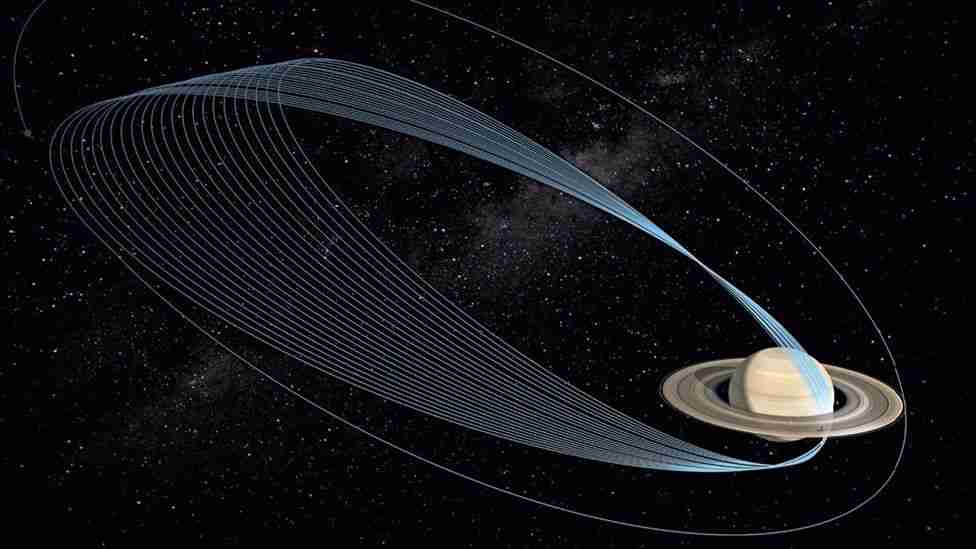
Another unique fact about Saturn is its ability to emit strong radio waves, detectable by Earth-based antennas. These high-energy emissions, linked to auroras at the planet’s poles, resemble Earth’s Northern and Southern lights.
First detected by the Cassini spacecraft in April 2002 which picked up these signals from a staggering 234 million miles away.
9. Saturn’s magnetic field is 578 times more powerful than Earth’s.
Saturn’s magnetic field, while smaller than Jupiter’s, is a staggering 578 times stronger than Earth’s, enveloping the planet, its rings, and many moons within its vast magnetosphere.
This powerful field extends far into space, even interacting with the moon Enceladus, and is responsible for creating stunning auroras near Saturn’s poles, similar to the Northern and Southern lights on Earth.
10. Saturn’s rings are kept in place by the Shepherd moons.
Saturn’s iconic rings are meticulously maintained by the gravitational pull of small moons known as “shepherd moons.” These moons orbit near the rings’ edges or within gaps, their gravity ensuring the rings’ sharply defined edges.
By deflecting ring particles from their paths, either through direct proximity or orbital resonances, shepherd moons play a crucial role in preserving the rings’ stunning structure.
11. What is the name of Saturn’s largest moon?
Titan, Saturn’s largest moon, surpasses even the planet Mercury in size, making it the second-largest moon in our solar system, behind Jupiter’s Ganymede.
Shrouded in a golden haze, Titan’s atmosphere is rich in nitrogen, similar to Earth’s. Scientists believe it hosts rivers, lakes, and oceans of liquid hydrocarbons like ethane and methane.
12. The hexagon-shaped storm on Saturn’s north pole is wider than Earth.
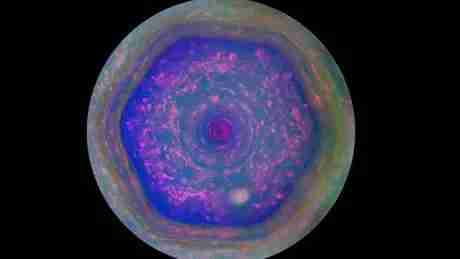
Saturn’s north pole harbors a unique hexagon-shaped storm, wider than Earth, with sides stretching about 14,500 km long. This atmospheric phenomenon, first discovered in 1981, showcases a jet stream moving at 320 km/h.
The storm, larger than any hurricane on Earth, spans over 29,000 km across, offering a stunning yet mysterious glimpse into the dynamics of Saturn’s atmosphere.
13. Why is Saturn losing its rings?
NASA’s Voyager missions revealed that Saturn is gradually losing its rings. The rings, made of ice, dust, and rock, are being drawn into Saturn by gravity, creating a dusty rain of ice particles influenced by the planet’s magnetic field.
This process, where Saturn attracts and vaporizes ring material, essentially means Saturn is slowly consuming its iconic rings.
14. Saturn’s moon Tethys has a massive canyon called Ithaca Chasma.
Tethys, Saturn’s fifth largest moon, has a colossal canyon named Ithaca Chasma. Stretching 2,000 km long and up to 100 km wide, this massive valley runs about three-quarters of the way around Tethys, making it one of the solar system’s longest canyons.
Nearly concentric with the Odysseus crater, the Ithaca Chasma is a striking feature visible near the moon’s terminator.
15. Saturn’s upper atmosphere is divided into bands of clouds.
Another lesser-known fact about Saturn is its layered cloud system, dividing the upper atmosphere into bands. The topmost clouds consist of ammonia ice, followed by bands of water ice and ammonium hydrosulfide ice as you move inward.
Saturn’s atmosphere houses three distinct cloud decks: ammonia, ammonium hydrosulfide, and water clouds, with smog hazes found at very high altitudes above these cloud bands.
16. NASA is planning to send a probe to Titan.
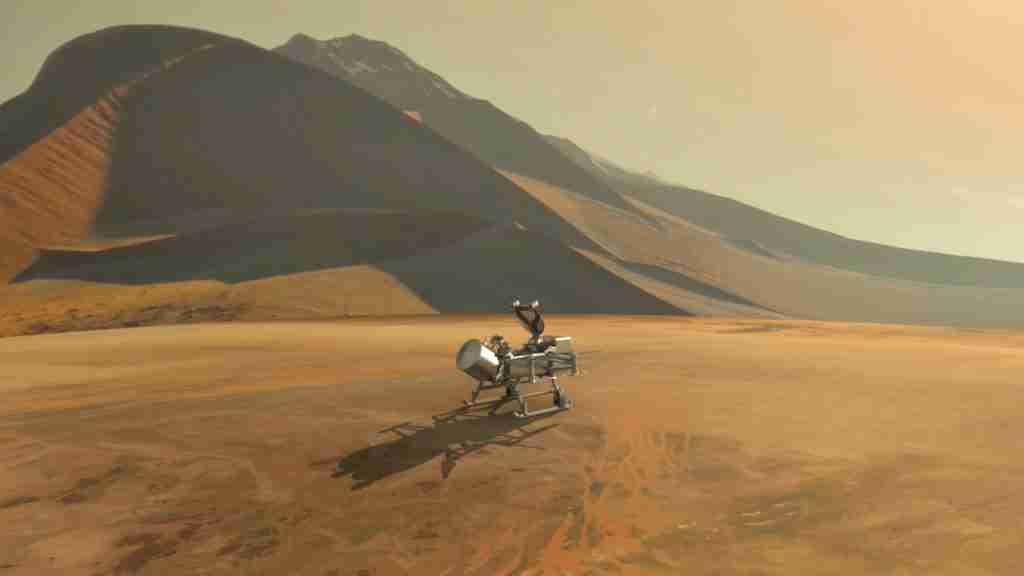
NASA’s Dragonfly mission, set for launch in July 2028, aims to send a robotic rotorcraft to Titan, Saturn’s largest moon, with an expected arrival in 2034.
This innovative mission will explore Titan’s surface and atmosphere, using the Dragonfly Mass Spectrometer among other instruments, to study the moon’s complex chemistry, potentially shedding light on the origins of life.
17. Saturn’s moon Hyperion has an irregular shape and chaotic rotation.
Saturn’s moon Hyperion is known for its irregular shape and unpredictable, chaotic rotation. Unlike most moons, it isn’t tidally locked to Saturn and lacks a consistent rotation period.
This chaotic behavior is attributed to its elliptical orbit, a 3:4 orbital resonance with Titan, and its irregular shape, causing Hyperion to tumble unpredictably as it orbits Saturn, making its future spin orientation impossible to forecast.
18. Saturn is the most oblate planet in the Solar System.
Saturn stands out as the most oblate planet in the Solar System, primarily due to its rapid rotation and low density, which is the lowest among all planets.
This unique combination causes a noticeable difference in its equatorial and polar diameters, with the equatorial diameter being almost 10 percent larger. Through a telescope, Saturn’s flattened appearance is a direct result of this oblateness.
19. Does Saturn have water?
Yes, Saturn does contain water. Its atmosphere holds traces of water vapor, especially in the deeper layers, with the presence of water in the upper atmosphere being a long-standing mystery since its discovery in 1997.
Moreover, Saturn’s magnificent rings are primarily composed of water ice. Titan, Saturn’s largest moon, features a surface rich in water ice, and hydrocarbon ice.
20. Saturn’s moon Mimas causes tidal force waves in the rings.
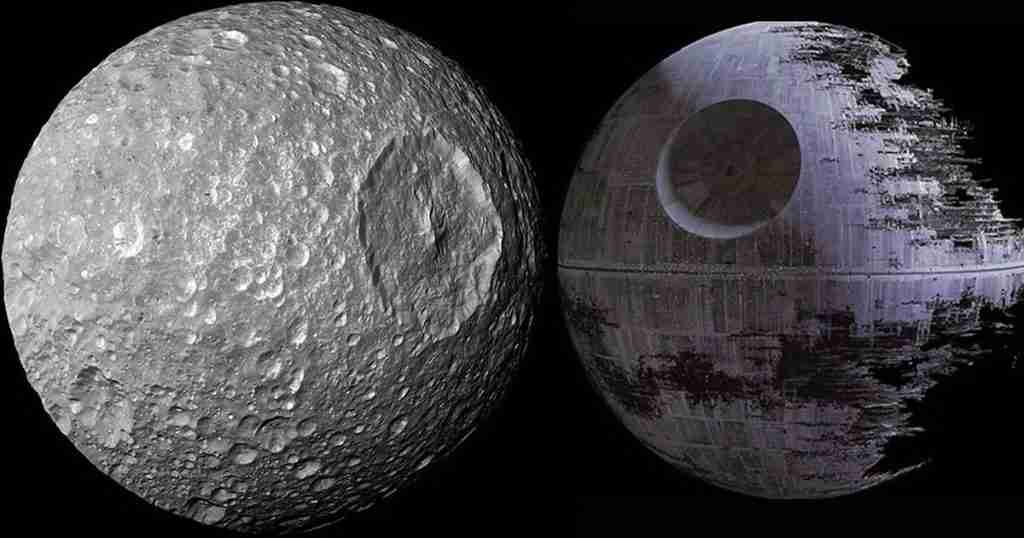
Saturn’s moon Mimas exerts tidal forces that play a crucial role in shaping the planet’s rings, creating distinctive waves and gaps. Notably, Mimas is key in forming the Cassini Division, a clear gap between Saturn’s A and B rings.
This is due to a 2:1 orbital resonance, where particles are pulled into new orbits, maintaining the division’s clarity through Mimas’s gravitational influence.
21. Saturn is the most distant visible planet from Earth.
Another unique fact of Saturn is that it holds the distinction of being the farthest planet visible from Earth without the aid of telescopes, known since ancient times and named after the Roman god of agriculture.
As the most distant of the five planets easily seen with the naked eye, Saturn shines as the fifth brightest object in the solar system, offering a spectacular view through binoculars or a small telescope.
22. So far four spacecraft, including Cassini, have explored Saturn.
Four spacecraft have ventured to Saturn, including Pioneer 11, Voyager 1 and 2, and the Cassini-Huygens mission. Cassini, in particular, orbited Saturn from July 2004 to September 2017, providing an unprecedented wealth of data.
The first ‘up close’ view of the rings was by Pioneer 11 spacecraft which flew by Saturn on September 1, 1971. These missions have collectively deepened our understanding of Saturn, marking significant milestones in space exploration.
FAQs
Saturn is about 1.4 billion kilometers (or roughly 886 million miles) from the Sun. This vast distance places it as the sixth planet in our solar system, orbiting far beyond Earth.
Saturn has been known since ancient times, and observed by various cultures across the world. It wasn’t “discovered” in the modern sense but has been part of human observation and mythology for thousands of years.
The distance between Saturn and Earth varies due to both planets’ orbits. At its closest, Saturn is about 1.2 billion kilometers (or about 746 million miles) from Earth, and at its farthest, about 1.7 billion kilometers (or about 1.1 billion miles).
Saturn’s atmosphere is predominantly made of hydrogen and helium, similar to Jupiter’s. It also contains traces of water, methane, ammonia, and other gases, contributing to its layered cloud bands and dynamic weather systems.
The temperature on Saturn varies by altitude, but at the cloud tops, it’s quite cold, with average temperatures around -178 degrees Celsius (-288 degrees Fahrenheit). Deeper into the atmosphere, temperatures increase due to the greenhouse effect.

